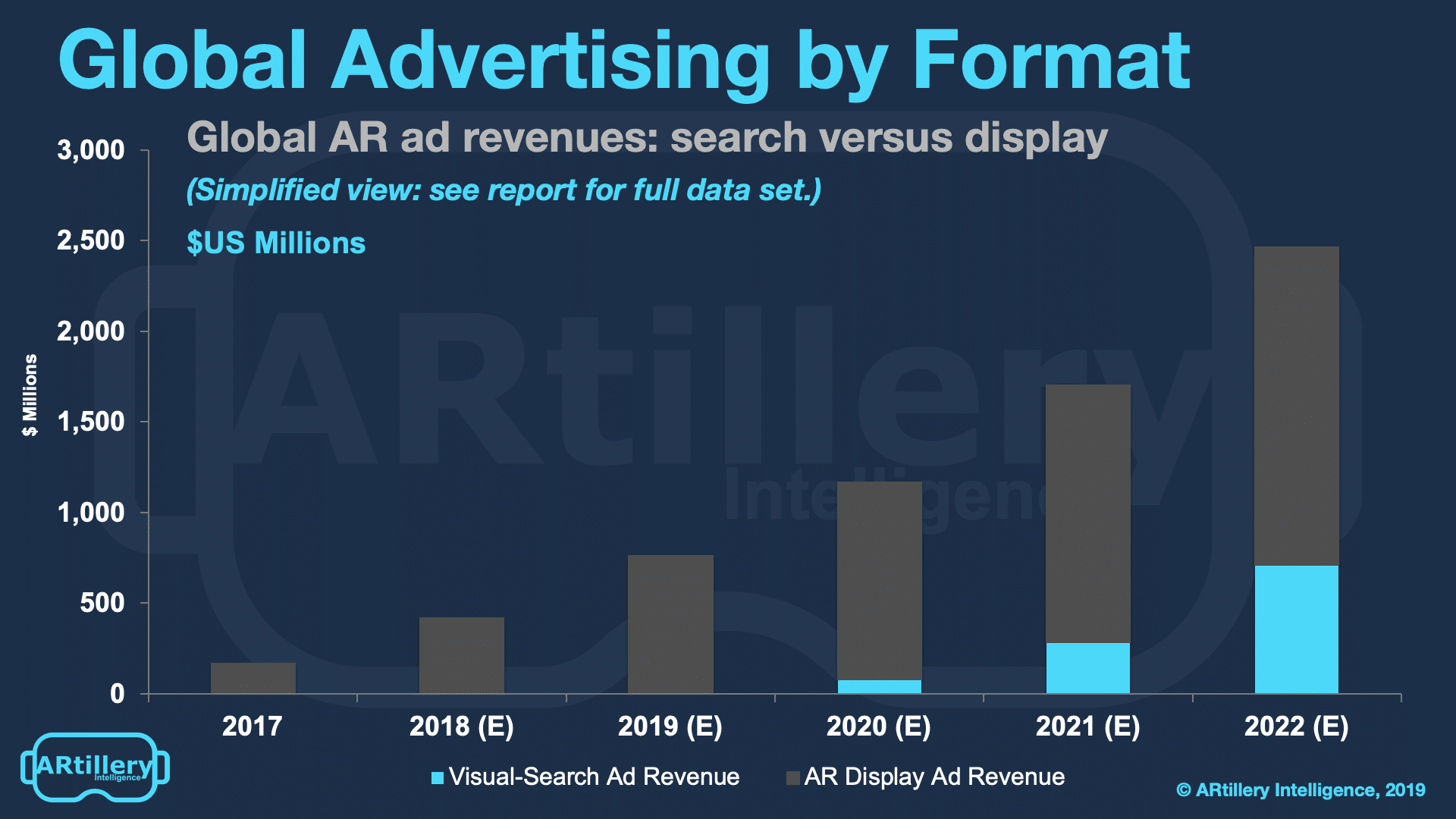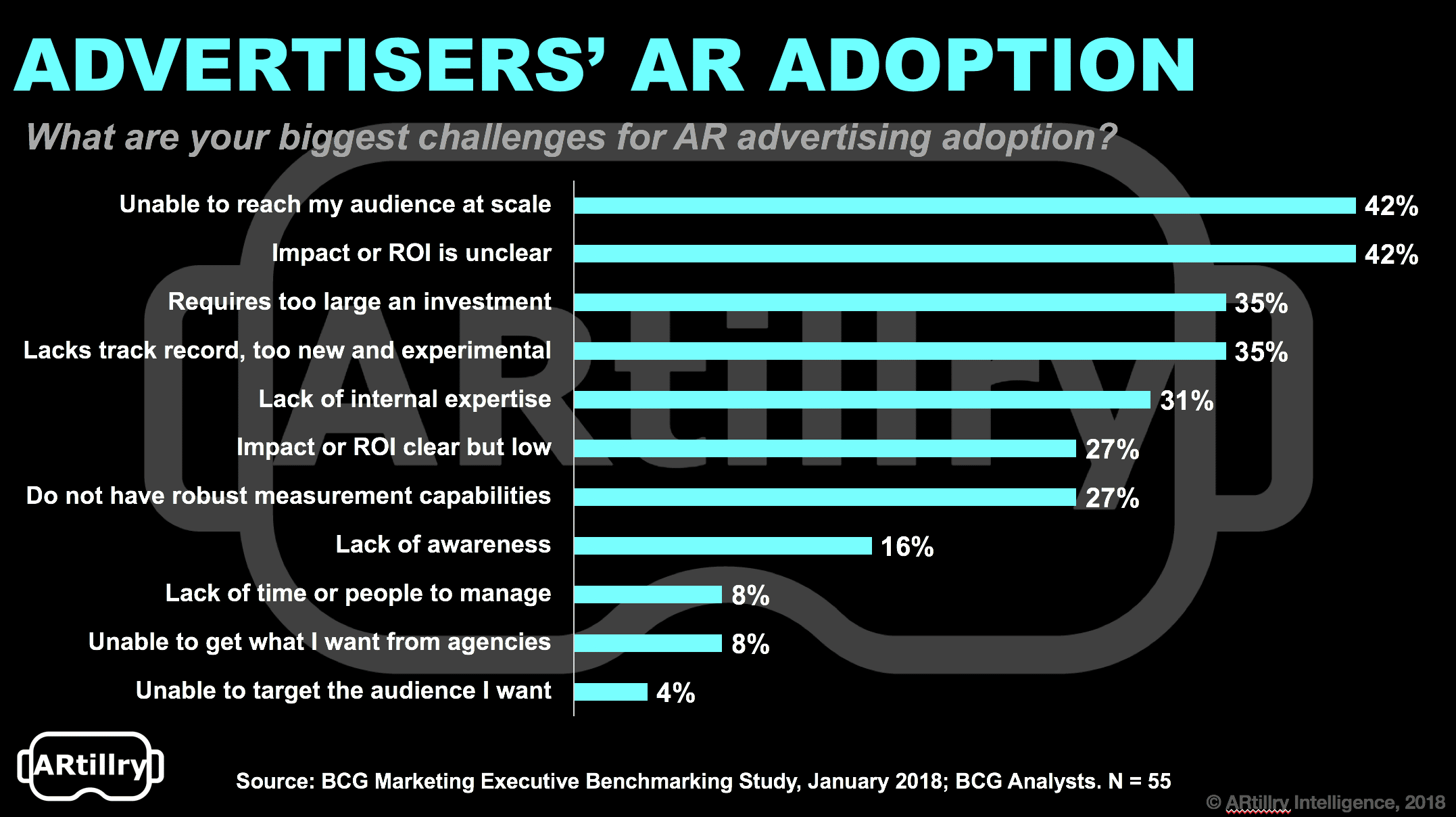
Picking up where we left off last week in outlining our 2019 predictions, it’s time to drill down on #3: AR advertising revenue growth. We project it to reach $761 million in 2019 and $2.46 billion by 2022. That’s up from $418 million last year.
In fact, among the AR revenue categories developing, advertising is one of the few already bearing fruit. So far, this mostly includes branded AR selfie lenses for fitting products (think: cosmetics), but categories will expand as AR continues to migrate to the rear-facing camera.
Brands so far not only love the idea of immersive product try-ons, but the ROI metrics validate that love (see table below). AR lenses also naturally possess a rare capacity for “full funnel” consumer engagement. In other words, they span brand awareness and measurable conversions.
This is starting just as the digital ad world did, with display ads (in this case, lenses) out of the gate first. Visual search will follow, led by Google, Pinterest and Snapchat. It will bloom later due to technical complexity but will likely carry more “high-intent” value… just like search itself.

Arms Race
As for market share, Snap derived an estimated $236 million of the $418 million stated above. This makes it AR’s revenue leader. Many people point to Pokemon Go’s $2+ billion in in-app-purchases (not ad revenue), but that isn’t directly-attributable to AR, depending on your definition.
Snapchat continues to double down on AR lenses. It recently extended lenses from selfie fodder to rear-facing camera AR that augments the world. That includes more utilitarian and intelligent AR that overlays graphics based on scene awareness, or solves math problems on the fly.
But Facebook looms ever-larger in Snap’s rearview mirror and has a knack for copying it. It got a later start with AR lenses, but could gain market share as it blitzes AR ad spend from existing advertisers. Its installed base is larger — 1.5 billion devices — and it’s investing a lot in AR.
Facebook’s AR push is driven by diversified revenue (like Snap), and as diminishing News Feed ad inventory forces it to find other pastures. That includes Messenger and, notably, Instagram. The latter is the sleeping giant, with an aligned use case and hints of AR features already evident.
The opportunity also extends beyond walled gardens. Broader cross-platform reach could come from Web AR, where capabilities are limited but catching up. That’s being led by innovators like 8th Wall, which is already working with advertisers like Miller Coors and Sony Pictures.

The Bad News
Despite all this momentum, AR advertising has some weaknesses to acknowledge. First, there’s a relatively low overall user base of about 129 million active AR users globally (AR-compatible devices is the wrong figure). There are also inherently short AR sessions due to arm fatigue.
In combination, these factors diminish ad inventory, thus gating near-term revenue capacity. Moreover, brand advertisers are very reach-driven. Despite strong campaign performance, the low stakes aren’t enough to excite most brands outside of a small batch of early adopters.
But it’s a matter of perspective. Potential reach exists, including the 700-million “television-sized” audiences Snap can reach episodically with AR lenses. Despite that, the prevailing sentiment from famously-laggard and comfort zone-bound Madison Avenue is that it’s a low-reach play.
Among those uninterested, the top two reasons include a lack of scale and unclear ROI (see below). This represents a clear disconnect because actual performance metrics counter these claims, including Snap’s growing and validated AR lens reach and the ROI table above.

In Perspective
The Madison Avenue disconnect speaks to the need for education, which will take a while if history is any indication. Brand acclimation to smartphone advertising is still underway, ten years later. For example, effectiveness with mobile location targeting is still pretty ham-handed.
But the real AR ad successes will go beyond awareness and even genuine interest and adoption. Effectiveness and sustained spending will come down to execution. And that will be an even longer learning curve, which will be all about native thinking and measuring the right things.
“With immersive technology, everyone’s going to ask for the ROI,” You Are Here Labs’ futurist Kathy Hackl said at AWE. “Do we need to create new metrics… something like return on engagement or whatever that would translate to? There’s definitely going to be new metrics.”
So if these challenges abound, why are we so bullish on AR advertising, per the $761 million projection for 2019. The answer is that we’re not. These figures are low compared to other projections, and about .1% of total global ad spend. It will be opportune, but a slow climb.
For more on this topic including case studies and market-sizing, see ARtillery Intelligence’s report on AR Advertising. Market-sizing methodology and credentials can be seen here.
For deeper XR data and intelligence, join ARtillry PRO and subscribe to the free AR Insider Weekly newsletter.
Disclosure: AR Insider has no financial stake in the companies mentioned in this post, nor received payment for its production. Disclosure and ethics policy can be seen here.
Header Image Credit: Shopify
